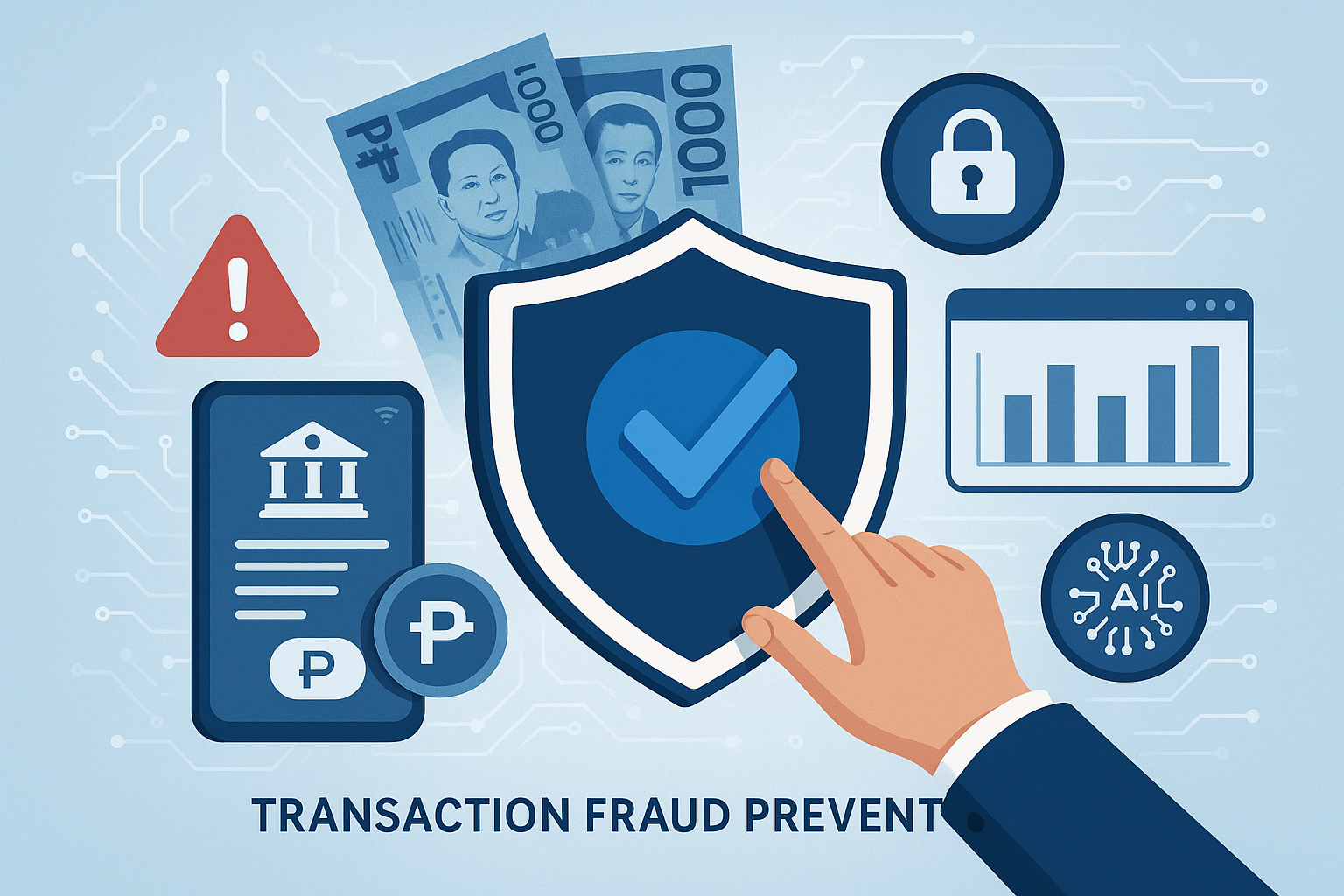Winning the Race Against Transaction Fraud: Smarter Detection for Smarter Criminals
.svg)
Transaction fraud is evolving faster than ever, demanding smarter detection strategies from financial institutions.
As real-time payments and digital transactions surge, fraudsters are using increasingly sophisticated methods to exploit vulnerabilities—leaving banks, payment providers, and fintechs scrambling to keep pace. Traditional rule-based systems are no longer enough; institutions must adopt intelligent, adaptive fraud detection frameworks to spot anomalies before they cause serious damage.
In this article, we explore how transaction fraud detection is changing, the key challenges institutions face, and the advanced techniques that can help you outpace evolving threats while protecting customers and preserving trust.

The Evolving Landscape of Bank Fraud: A New Era of Digital Threats
Bank fraud has evolved far beyond physical theft. In today’s digital economy, cybercriminals orchestrate complex, often invisible schemes that exploit the speed and scale of digital transactions. From fake account openings to real-time payment fraud, the fraud landscape is becoming more dynamic—and more dangerous.
The rise of digital banking has been a double-edged sword. While it offers customers greater convenience, it has also introduced new vulnerabilities that fraudsters are quick to exploit. Using tactics such as phishing, credential stuffing, malware, and synthetic identities, criminals can infiltrate banking systems and carry out unauthorised transactions at an alarming speed.
These fraud actors often operate as part of global, decentralised networks, which makes identifying and disrupting them more challenging. In many cases, they deploy social engineering techniques to trick users into revealing sensitive information or authorising fraudulent activity themselves, bypassing conventional security controls.
To combat this, financial institutions must invest in adaptive transaction fraud detection systems that continuously analyse behaviour patterns, detect anomalies, and flag emerging threats in real time. Static rules alone are no longer effective. Instead, modern systems must combine real-time data analytics, AI-driven risk scoring, and cross-channel visibility to stay one step ahead.
As fraud tactics continue to evolve, so must the tools we use to detect them.
{{cta-first}}
The Role of Machine Learning and AI in Fraud Detection
Machine learning (ML) and artificial intelligence (AI) are pivotal in modern fraud detection. These technologies analyse vast amounts of data to identify unusual patterns. They have significantly enhanced the speed and accuracy of fraud detection systems.
ML models learn from historical data, continuously improving over time. This capability allows them to detect fraud in its nascent stages. AI algorithms can identify subtle anomalies that human analysts might miss.
Moreover, these technologies reduce false positives, a common issue in fraud detection. Accurate detection of fraudulent transactions minimises disruption to legitimate customer activities. Consequently, it improves customer satisfaction and trust in financial institutions.
Some key benefits of integrating ML and AI in fraud detection include:
- Enhanced ability to process and analyse large data sets.
- Improved accuracy in detecting fraud patterns.
- Reduction in false positives and better customer experience.
In addition, AI can adapt to emerging fraud schemes. As fraud strategies evolve, AI systems adjust, learning new patterns. This adaptability is crucial for staying ahead of sophisticated fraudsters.
Ultimately, ML and AI provide a competitive edge in the fight against financial crime. These technologies ensure that financial institutions remain one step ahead of fraudsters.
Understanding Machine Learning Models
Machine learning models play a crucial role in recognising fraud. They operate by learning patterns from massive data sets. By doing so, they identify irregularities that may signal fraudulent activity.
These models differ in complexity and functionality. Some use supervised learning, where they are trained with labelled data. Others use unsupervised learning, seeking patterns without predefined outcomes.
Supervised models are efficient in structured environments. They rely on historical fraud data to predict new incidents. However, unsupervised models excel when new fraud types emerge.
Additionally, hybrid models combine both approaches. They learn from structured data while adapting to new fraud patterns. This versatility makes them effective in dynamic fraud detection scenarios.
Continuous improvements in ML models enable enhanced fraud protection. As these models evolve, they provide increasingly robust defences against fraud.
Real-Time Detection: The Game Changer
Real-time detection revolutionises fraud prevention. It allows financial institutions to identify and stop fraud instantly. This capability is essential in the fast-paced digital banking environment.
Previously, fraud detection depended on batch processes. Transactions were often reviewed after completion, delaying responses. Real-time systems change this by analysing transactions as they occur.
These systems leverage ML to assess risk instantly. They evaluate transaction characteristics and customer behaviour. Suspicious activities trigger alerts immediately, preventing potential losses.
Furthermore, real-time detection minimises damage from fraud. By stopping transactions mid-process, it protects customers and institutions. This proactive approach ensures a swift response to threats.
In essence, real-time detection has become a cornerstone of effective fraud prevention strategies. It empowers institutions to act swiftly, safeguarding against emerging threats.
Digital Banking and the Rise of Fraudulent Transactions
Digital banking has transformed the financial landscape, offering convenience and accessibility. However, it has also opened new avenues for fraudulent transactions. As digital banking services expand, so do the methods and techniques employed by fraudsters.
One significant challenge is the increased anonymity in online transactions. Without physical presence, it becomes easier for criminals to disguise their identities. This anonymity complicates the detection of fraudulent activities.
Moreover, the sheer volume of transactions in digital banking can overwhelm traditional monitoring systems. Fraudulent activities may blend in, going unnoticed amidst legitimate transactions. This makes robust transaction monitoring systems a necessity.
Another issue is the rapid evolution of digital fraud tactics. Cybercriminals constantly adapt, employing sophisticated technologies and techniques. Financial institutions must remain vigilant, updating their systems to counter these evolving threats.
In response, many banks are turning to advanced analytics and AI-driven technologies. These tools help to pinpoint anomalies and mitigate risks swiftly. By leveraging technology, financial institutions can better safeguard against the ever-present threat of digital fraud.
The Impact of Social Media on Identity Theft
Social media has become a part of daily life, but it has its risks. One such risk is the potential for identity theft. Fraudsters use social media to gather personal information, often without users realizing it.
Many individuals share sensitive details on social media platforms, including birth dates and locations. These details can be exploited by criminals. They use this information to impersonate individuals and commit fraud.
Additionally, social engineering tactics are prevalent on social media. Fraudsters create fake profiles, gaining trust to extract information. Once acquired, this data becomes a tool for identity theft, affecting both individuals and financial institutions.
The spread of social media has therefore increased the importance of awareness and caution. Users must be careful about the information they share. Financial institutions, likewise, need to educate customers about potential threats.
In conclusion, while social media connects people, it also provides opportunities for fraud. Both users and financial entities must work together to combat identity theft. Awareness and proactive measures are key to mitigating risks in this digital age.
Transaction Monitoring: Flagging Suspicious Activities
Transaction monitoring is crucial for bank transaction fraud detection. It involves scrutinising financial transactions to identify suspicious activities. This process helps financial institutions prevent potential fraud losses.
Modern transaction monitoring systems analyse vast amounts of data. They employ algorithms to detect irregularities and trigger alerts. These alerts notify investigators about potentially fraudulent transactions.
Effective transaction monitoring relies on several key factors. First, it requires a comprehensive understanding of normal transaction patterns. Knowing what constitutes typical behaviour allows institutions to spot deviations.
Additionally, the use of advanced analytics plays a significant role. Analytics tools can process complex datasets quickly. They identify patterns that might indicate fraudulent activity.
Implementing a robust transaction monitoring system involves several steps:
- Establishing baseline transaction behaviours for different customer segments.
- Continuously updating systems to accommodate new fraud trends.
- Employing machine learning models to refine detection capabilities.
- Integrating real-time monitoring for immediate threat response.
Transaction monitoring is not a one-size-fits-all solution. It must adapt to changes in customer behavior and fraud techniques. Continuous refinement and adaptation ensure its effectiveness.
Ultimately, transaction monitoring serves as the frontline defence against bank fraud. It helps financial institutions detect threats early and minimise losses. By investing in sophisticated monitoring, banks can enhance their fraud prevention strategies.
Trigger Alerts and Fraud Prevention Mechanisms
Trigger alerts are an essential component of fraud prevention. They act as an early warning system, flagging suspicious activities. These alerts enable a quick response to potential fraud threats.
When a transaction deviates from established norms, the system triggers an alert. This deviation could be a sudden large transaction or unusual account activity. Such alerts allow investigators to intervene before any financial loss occurs.
Developing effective trigger alerts involves understanding customer behaviour deeply. By analysing typical transaction patterns, systems can set precise thresholds for alerts. This minimises false positives and ensures only genuine threats are flagged.
In conclusion, trigger alerts play a pivotal role in fraud detection. They are vital for preemptively identifying and preventing fraudulent transactions. A well-calibrated alert system enhances a bank's ability to protect its customers and assets.
Customer Data in Transaction Fraud Detection: Balancing Security and User Experience
Customer data lies at the heart of effective transaction fraud detection. From behavioural patterns to device fingerprints, data plays a critical role in identifying anomalies and preventing fraudulent activities. But while security is paramount, preserving a seamless customer experience is equally essential.
To secure customer data, banks must adopt robust cybersecurity practices. This includes end-to-end encryption, tokenisation, and secure access controls—all designed to protect sensitive information from unauthorised access and breaches. These techniques ensure that even if data is intercepted, it remains useless to cybercriminals.
However, heightened security shouldn’t come at the cost of user convenience. Overly complex authentication methods or intrusive fraud checks can result in friction-filled customer journeys, leading to frustration or even abandonment of legitimate transactions.
To address this, banks are increasingly investing in intelligent fraud detection systems that operate silently in the background. By leveraging AI and behavioural analytics, these systems can verify user authenticity in real time without interrupting the flow, triggering alerts only when a genuine anomaly is detected.
Transparency is also key. Educating customers on how their data is used to prevent fraud builds trust and cooperation. When users understand that their personal data helps protect their accounts and funds, they are more likely to engage positively with verification and fraud prevention protocols.
In today’s environment, financial institutions must strike a delicate balance: deploying secure and intelligent transaction fraud detection tools that protect users, without undermining their trust or experience.
Analyzing Customer Behavior for Fraud Detection
Customer behaviour analysis is a critical tool in detecting fraud. By understanding typical user actions, banks can identify anomalies. These deviations often indicate possible fraudulent activities.
Machine learning models excel in behaviour analysis. They process vast amounts of data to recognise patterns. This capability allows for the pinpointing of suspicious activities in real time.
Furthermore, behavioural biometrics enriches fraud detection methods. By monitoring user interactions, such as typing rhythm, banks can spot abnormalities. This non-intrusive method adds an extra layer of security.
Incorporating behaviour analysis into fraud detection strategies enhances accuracy. It helps banks flag potential threats swiftly and precisely. Ultimately, this method strengthens the institution's defences against sophisticated fraud techniques.
Regulatory Compliance and Fraud Detection
Regulatory compliance is the backbone in bank transaction fraud detection. It guides how financial institutions approach fraud prevention. Adhering to regulations ensures that systems meet legal standards for safeguarding transactions.
Compliance frameworks, such as the Financial Action Task Force (FATF) recommendations, establish best practices. These practices include stringent monitoring of suspicious activities and comprehensive reporting protocols. Such measures are crucial in the fight against money laundering and other financial crimes.
Staying compliant helps mitigate legal risks and enhances operational integrity. It empowers banks to implement robust systems that detect fraudulent activities efficiently. Moreover, compliance fosters trust with stakeholders by demonstrating a commitment to ethical standards. This trust is essential in maintaining healthy customer relationships and institutional reputation.
Financial institutions must continually adapt to evolving regulations. This adaptability ensures that fraud detection methods remain effective and compliant. It also highlights the need for ongoing education for professionals in the sector. Understanding the legal landscape is as vital as technological acumen in this field.
The Future of Fraud Detection: Trends and Innovations
The future of fraud detection is shaped by rapid technological advancements. Emerging trends suggest a shift towards more sophisticated and proactive measures. These innovations promise enhanced efficiency in identifying and preventing fraudulent activities.
Key trends include increased use of artificial intelligence and machine learning. These technologies offer predictive analytics capabilities that anticipate fraud before it occurs. By analysing vast datasets, financial institutions can uncover hidden fraud patterns.
Another significant innovation is the integration of blockchain technology. Blockchain enhances transparency and security in financial transactions. Its decentralised nature reduces the risk of data breaches and fraudulent modifications.
In the coming years, we will likely witness these developments:
- Increased automation in fraud detection processes
- Wider adoption of advanced analytics for fraud prevention
- Integration of blockchain for secure transaction records
These trends highlight the potential for transformative changes in fraud detection. Financial institutions must embrace these innovations to remain competitive and secure. By doing so, they can safeguard themselves and their customers against emerging threats.
The Potential of Consortium Data Sharing
Consortium data sharing offers a collaborative approach to fraud detection. By pooling data, financial institutions can leverage shared intelligence. This collaboration improves the accuracy of identifying fraudulent activities.
Shared data enhances pattern recognition across organisations. It enables faster detection of complex fraud schemes. This collective approach reduces the chances of fraud going undetected.
The benefits of consortium data sharing are clear. It fosters stronger industry-wide defences against financial crime. Moreover, it emphasises the importance of cooperation and shared responsibility.
Biometric Authentication and Behavioural Biometrics
Biometric authentication is revolutionising how we verify identity. Utilising unique physical traits, such as fingerprints or facial features, it offers strong security. This technology significantly reduces the risk of identity theft in banking.
Behavioural biometrics adds an additional layer of security. It analyses user behaviour patterns, like typing speed or mouse movements. Any deviation from the norm can trigger alerts, flagging potential fraud.
Both technologies enhance customer experience by simplifying authentication processes. They provide a seamless and secure way for users to access accounts. This ease of use boosts customer satisfaction while maintaining robust security.
Financial institutions are progressively adopting these biometric technologies. Their combination of security and user-friendliness is a winning formula in fraud prevention. As they develop, these technologies will play a central role in future banking security.
Overcoming Challenges in Bank Transaction Fraud Detection
Detecting fraud in bank transactions comes with various challenges. As fraudsters become more sophisticated, identifying fraudulent patterns becomes harder. This complexity demands more advanced detection methods and technologies.
Financial institutions often struggle with the volume of transaction data. The sheer amount can overwhelm systems and delay fraud detection efforts. To tackle this, real-time analytics and machine learning models are essential. They help in swiftly processing data and identifying anomalies.
Moreover, balancing fraud prevention with customer experience is crucial. Tight security measures can sometimes inconvenience legitimate customers. Therefore, institutions must implement strategies that protect and streamline customer interaction. This ensures customer satisfaction while maintaining robust security.
Integrating Legacy Systems with Modern Technologies
Integrating legacy systems poses challenges for financial institutions. These older systems might not support the latest fraud detection technologies. Therefore, banks often face compatibility issues when trying to upgrade.
However, solutions exist through middleware and APIs, which bridge the gap between old and new systems. By carefully planning and executing these integrations, institutions can enjoy enhanced security features without completely overhauling their existing infrastructure. This approach helps in making the transition smoother and more cost-effective.
{{cta-ebook}}
Conclusion: Strengthening Transaction Fraud Detection with Tookitaki
In the evolving landscape of digital fraud, financial institutions must move beyond reactive measures and adopt proactive, intelligent solutions. Effective transaction fraud detection is no longer optional—it’s a critical component of building trust and protecting customers in real time.
Tookitaki’s FinCense Fraud Prevention solution empowers institutions to detect and prevent over 50 types of fraud, including account takeovers, money mule activity, and social engineering scams. Powered by AI and backed by the AFC Ecosystem, FinCense delivers real-time risk detection with 90%+ accuracy across billions of transactions.
Its intelligent alerting system, customizable fraud scenarios, and seamless integration with your existing infrastructure help streamline investigations and reduce operational burden, allowing your teams to focus on the threats that matter most.
As fraud tactics grow more sophisticated, Tookitaki helps you stay one step ahead—with smarter, scalable, and adaptive transaction fraud detection that’s built for the future of financial services.
Safeguard your institution, protect your customers, and lead with trust.
Experience the most intelligent AML and fraud prevention platform
Experience the most intelligent AML and fraud prevention platform
Experience the most intelligent AML and fraud prevention platform
Top AML Scenarios in ASEAN

The Role of AML Software in Compliance

The Role of AML Software in Compliance










